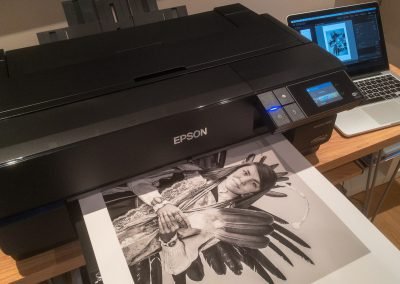Picture Mounting and Framing for Photographers – Part 1

Double suede mats, anti-reflective museum glass, wood frame. A frame like this can cost much more than the print it contains.
At one time or another, many photographers come to the point where we want to display our pictures on the wall. To varying degrees, most photographers that I speak with struggle with the myriad choices and costs related to finishing, mounting and framing their prints.
Of course, the potential applications and solutions are infinite and can range from a small photo print in a simple store-bought frame to a large-format canvas in a custom-made frame. This can be mind bending stuff, so in this article I’m going to try to simplify things as much as possible to help you make confident, straightforward decisions.
This article is comprised of two parts: this one, which provides a high-level, general overview of the picture mounting and framing process, and Part 2 (coming soon), in which we’ll examine some ways to improve efficiency and reduce costs.
The most important considerations for your presentation options should be made according to
- the size of the print
- the wall space where the picture will hang
- and for how long.
We’ll discuss the approach for a single print and extrapolate the process to the display of multiple pieces.
Tip: To save yourself lots of time and effort, pay close attention to the mounting and framing you see used on pictures everywhere you go—especially exhibitions. Simply copy the styles and materials you like the best… no need to re-invent the wheel!
Bonus tip! Often you can achieve the same finished look using several different approaches, which presents opportunities to save money. Stay tuned for Part 2!
Print media
Begin with the end in mind: clearly visualise how you want the finished/mounted/framed print to look.
First, let’s consider the print itself. The production process is best started by making a good choice for the type of substrate (aka the ‘media’) on which the print is actually made. Is it photo paper? Or fine art paper with a matte finish and a notable texture? Or canvas? Metal? Et cetera.
I always advocate matching each image with its ideal substrate. Some images look best on matte paper, others on something more glossy. Images with lots of fine details look amazing on textured media. As a photographer, the choice of print media is one of your key creative decisions—so give it the appropriate consideration.
I usually print on Arctic canvas from Colourbyte
… and I love many of the papers from Fotospeed (UK)

Traditional mounting with white mat and black frame. Store-bought frame with inexpensive glass – note the reflection. Darker prints are particularly susceptible to reflections when glazing is used.
Glazing
Depending on the print media, you’ll next need to determine whether or not to use glazing. If the print needs protection—especially if it will hang in a public area—using some type of glass or other clear protective barrier will likely be a smart decision.
Glass comes in a range of quality levels, with associated costs. At minimum, you should always use actual picture framing glass, which is made to provide UV protection. Most often, the glass in cheap store-bought frames isn’t actual picture framing glass and will offer no UV protection (but you can just use the frame and replace the glass).
Moving up in quality and cost, you’ll find options for glass offering varying levels of anti-reflective properties. So-called ‘museum glass’ is the best product but carries a hefty price tag. Although glass is quite tough and not easily scratched it can, of course, be broken—bear this in mind as we move ahead.
Using glass isn’t your only option. You can use clear acrylic sheets, such as the popular brands Plexiglas (in the U.S.) and Perspex (UK). Acrylic is far less likely to be broken, so it’s almost always your best choice for busy public exhibitions, but maybe not for installations in private homes. Acrylic does scratch more easily than glass, but any scuffs can often be polished out. Acrylic also comes in anti-reflective versions. Comparing similar UV and anti-reflective specifications, acrylic is generally more expensive than glass (except, possibly, at the very high end).
The decision whether or not to use any type of glazing is key because it can significantly affect the appearance of the picture. Also, using a sheet of glazing in front of the print will most often require a support structure, e.g. a frame, to hold it in place, which also significantly affects the appearance… more on framing in a moment.
Tru-Vue makes the best framing glass and acrylic
Tip: Another option is to use a face-mounted lamination process, where a photographic print is adhered to an acrylic sheet (often simply referred to as face-mounted acrylic). This lessens the need for an actual frame; in fact, these face-mounted products are usually displayed frameless, instead hung on the wall using an apparatus affixed to the back of the print. You can also have your image printed directly to acrylic. Bear in mind, though, that these two aforementioned processes are not at all ‘archival’ standard, which I’ll address later.
Matting and mounting
After glazing, the next decision is more creative: do you want a visible border or margin around the print? In the U.S., this is generally called a mat; in the U.K. it’s a mount; in French it’s a passe-partout—all the same thing. The mat serves two purposes: 1) it keeps the print from touching the glass, and 2) it can create a more pleasing (and impressive) appearance by having a space between the edge of the live image and the frame. If you’re going for a high-quality, traditional look, many photographic prints will look their best using a mat. The choices of the colour and width of the mat(s) then become crucial creative decisions. A white or ivory mount will work with a wide range of images and presents a simple, modest look, but in many environments a coloured or darker mount might look fantastic. You can also combine mounts, stacking one on top of another to get a layered effect.
Tip: Use Photoshop to mock up your mounting/framing options, especially when you’re producing bespoke work for a client.
Cotswold Mounts is one of the best suppliers in the UK (similar suppliers are found across the US)
https://www.cotswoldmounts.co.uk/
Framing
Whether or not you use a mat/mount, you will often want some type of frame structure to hang your photo print on the wall. The exceptions may be when your image is printed directly to a rigid substrate such as acrylic, metal etc. As mentioned earlier, a standard photo print can be laminated directly to acrylic or other rigid substrates, in many cases altogether eliminating the need for a decorative frame around the outside of the picture. For these types of presentations, a cleat or standoff is applied to the back of the panel which serves as a hanging point and visually sets the print away from the wall.
If you do want to use a frame, you have a vast range of choices for the moulding—the actual strip of wood, metal or other material that is assembled to construct the four sides of the frame. Mouldings range from simple to elaborate, and from inexpensive to incredibly exorbitant.
Once you know the moulding style you want and have calculated the size, the next issue to tackle is how the finished frame will be fabricated.
You have a few options here:
- Buy a pre-made frame (with or without glass and mat), such as from a retail store
- Order the moulding from a framer and have them join it
- Order the moulding and join it yourself (usually not the best idea)
- Custom-order the finished frame from an online seller

Hand embellished canvas with white, wood ‘tray’ frame. Some canvas prints look best with a frame, and this tray style presents a narrow gap around the edge of the canvas, similar to a shadowbox treatment.
Over the years, I’ve used all the above methods at various times, depending on the circumstances. The key is to know your options, remain flexible and open-minded, and be willing to do a little research for each framing project. With some experience, you’ll have a clearer idea of the best direction going into each new project.
A key consideration, particularly with frame choices, is whether you’re producing a single piece or a collection of works. One-offs are usually unique and can be done for the best results based on the specific criteria for that single print; when you’re dealing with more than one piece, you’ll often be looking to achieve uniformity and consistency, so compromises are appropriate to balance the set of photographs so they all look good together.
Regardless of the characteristics of each individual framing project, it’s important that, over time, you create your own personal style and refine your production choices based on your preferences for presenting your work. Developing consistency in your process certainly makes things easier and—more importantly—the impact, appearance and standing of your work will benefit greatly by presenting a consistent style.
Larson-Juhl is one of the best manufacturers of frame moulding internationally (but only sell through distributors and retail frame shops)
In the UK, you can find lots of great framing products from Lion
In Part 2 we’ll look at ways to streamline your framing choices and save money at the same time.
Considerations for very large works
Producing mounted and framed works beyond ‘poster size’ (e.g. bigger than, say, 20×30 inches or 50×75 cm) introduces some additional and important considerations.
To begin with, very large photographic prints on paper usually display some amount of visible waviness, rippling or buckling in the print surface if the paper is not mounted completely to a rigid substrate. Depending on the image, print media and circumstances, this may or may not pose a major issue. If adhering to archival methods is important, you should never permanently affix a print to a backing substrate; you’ll just have to live with any ripples. (More about archival methods is below.) But if maintaining an archival standard is not important, dry mounting can be very beneficial for the appearance of the print. The dry mount process uses a sheet of adhesive (usually heat-activated) to laminate the print to a backing board (usually foam-core). This process is permanent, so decisions about sizing, materials etc. are crucial.
Secondly, if very large works are glazed they should usually use acrylic, not glass. The issues are weight and brittleness: a very large sheet of picture framing glass is very heavy and can bow under its own weight away from the edges of the frame. If it sags enough in the middle, this can present a risk of cracking or it may even pop out of the frame. A large sheet of acrylic is lighter than glass and will not break. (If using actual glass is important for certain large-format installations, non-picture glass such as extra-strong, tempered glass can be used as a compromise.)
Considerations for public and temporary exhibitions
Your choices for mounting and framing need to be done with respect to where the work will be hanging. If it’s one (or a few) pieces going in a home or office, you can produce the mounting and framing in line with the style and requirements of the customer. The prints may not need a lot of protection, and you can work directly with the buyer to determine the choices of materials according to their taste and budget.
But if you’re producing work for exhibition, the criteria will usually be quite different. Again—is it just one piece you’re showing? A few? Dozens? How does the work need to appear within the context of the environment where it’s hanging? What is the expected traffic and activity around the work? Can people walk right up to it (and, likely, touch it)? You need to find a balance between your aesthetic intentions and practical concerns.
A key difference is that work being installed permanently will most likely experience much less handling than it would in a temporary exhibition. Whether you’re hanging a single piece in a group show or mounting a solo exhibition, your works will
a) be transported to the location,
b) handled and hung by a (potentially) unknown number of people
c) accessed by the viewing public when you’re not around and, ultimately,
d) taken down and either delivered back to you or (if it’s sold) taken to its permanent home.
All this handling and exposure can quite literally destroy your precious work so the decisions you make for mounting and framing must reflect this.
Archival methods and materials (aka ‘Conservation Framing’)
Following established standards for archival preservation of prints and artwork is an important consideration. This involves using methods and materials that will not damage, degrade or otherwise alter the print itself. Proper archival methods will greatly extend the expected life of a print, and can also make it easier should the mounting ever need to be reworked in the future.
To be sure, for many projects it’s fine to not worry too much about archival standards. For example, when you’re selling open-edition prints on standard photographic paper and keeping the price point low is more important than maintaining heirloom quality.
Otherwise, to produce fine art photography to the highest standards of quality and to ensure the longevity, integrity and value of the print, you’ll need to follow appropriate procedures. For example, the print itself should never be dry-mounted or otherwise permanently affixed to the backing board. Instead, use professional tape hinging methods so the print won’t move in the mount but is only attached at crucial points. All mats and mount boards, tapes and adhesives must be acid-free and, at minimum, you should use quality glass with good UV protection.
As you’d expect, doing your mounting and framing to conservation standards can cost more than non-archival methods. I’ll publish a future article covering archival methods in more detail. (in the meantime, there is lots of information online about this.)
Here are a few web sites to get you started:
https://www.universityproducts.com/conservation-framing/
http://www.conservationregister.com/PIcon-Mounting.asp
https://www.archivalmethods.com/blog/
Coming Up Next: In Part 2 we’ll look at ways to make the process easier and save money when mounting and framing your photographic prints. Stay tuned!












